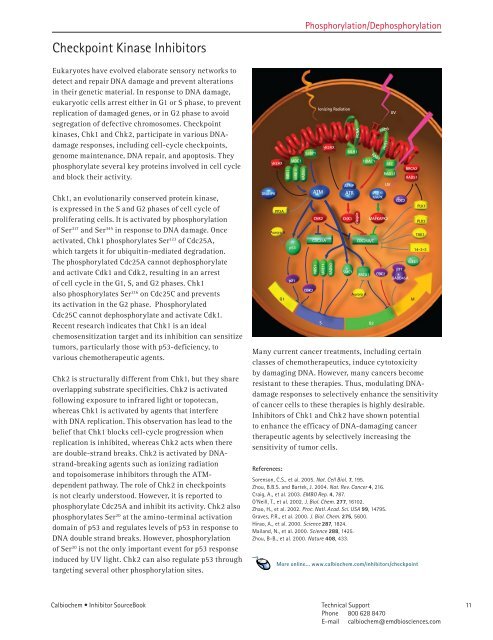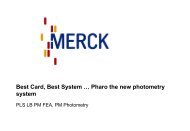Inhibitor SourceBook™ Second Edition
Inhibitor SourceBook™ Second Edition
Inhibitor SourceBook™ Second Edition
You also want an ePaper? Increase the reach of your titles
YUMPU automatically turns print PDFs into web optimized ePapers that Google loves.
Checkpoint Kinase <strong>Inhibitor</strong>s<br />
Eukaryotes have evolved elaborate sensory networks to<br />
detect and repair DNA damage and prevent alterations<br />
in their genetic material. In response to DNA damage,<br />
eukaryotic cells arrest either in G1 or S phase, to prevent<br />
replication of damaged genes, or in G2 phase to avoid<br />
segregation of defective chromosomes. Checkpoint<br />
kinases, Chk1 and Chk2, participate in various DNAdamage<br />
responses, including cell-cycle checkpoints,<br />
genome maintenance, DNA repair, and apoptosis. They<br />
phosphorylate several key proteins involved in cell cycle<br />
and block their activity.<br />
Chk1, an evolutionarily conserved protein kinase,<br />
is expressed in the S and G2 phases of cell cycle of<br />
proliferating cells. It is activated by phosphorylation<br />
of Ser 317 and Ser 345 in response to DNA damage. Once<br />
activated, Chk1 phosphorylates Ser 123 of Cdc25A,<br />
which targets it for ubiquitin-mediated degradation.<br />
The phosphorylated Cdc25A cannot dephosphorylate<br />
and activate Cdk1 and Cdk2, resulting in an arrest<br />
of cell cycle in the G1, S, and G2 phases. Chk1<br />
also phosphorylates Ser 216 on Cdc25C and prevents<br />
its activation in the G2 phase. Phosphorylated<br />
Cdc25C cannot dephosphorylate and activate Cdk1.<br />
Recent research indicates that Chk1 is an ideal<br />
chemosensitization target and its inhibition can sensitize<br />
tumors, particularly those with p53-deficiency, to<br />
various chemotherapeutic agents.<br />
Chk2 is structurally different from Chk1, but they share<br />
overlapping substrate specificities. Chk2 is activated<br />
following exposure to infrared light or topotecan,<br />
whereas Chk1 is activated by agents that interfere<br />
with DNA replication. This observation has lead to the<br />
belief that Chk1 blocks cell-cycle progression when<br />
replication is inhibited, whereas Chk2 acts when there<br />
are double-strand breaks. Chk2 is activated by DNAstrand-breaking<br />
agents such as ionizing radiation<br />
and topoisomerase inhibitors through the ATMdependent<br />
pathway. The role of Chk2 in checkpoints<br />
is not clearly understood. However, it is reported to<br />
phosphorylate Cdc25A and inhibit its activity. Chk2 also<br />
phosphorylates Ser 20 at the amino-terminal activation<br />
domain of p53 and regulates levels of p53 in response to<br />
DNA double strand breaks. However, phosphorylation<br />
of Ser 20 is not the only important event for p53 response<br />
induced by UV light. Chk2 can also regulate p53 through<br />
targeting several other phosphorylation sites.<br />
Calbiochem • <strong>Inhibitor</strong> SourceBook<br />
Phosphorylation/Dephosphorylation<br />
Many current cancer treatments, including certain<br />
classes of chemotherapeutics, induce cytotoxicity<br />
by damaging DNA. However, many cancers become<br />
resistant to these therapies. Thus, modulating DNAdamage<br />
responses to selectively enhance the sensitivity<br />
of cancer cells to these therapies is highly desirable.<br />
<strong>Inhibitor</strong>s of Chk1 and Chk2 have shown potential<br />
to enhance the efficacy of DNA-damaging cancer<br />
therapeutic agents by selectively increasing the<br />
sensitivity of tumor cells.<br />
References:<br />
Sorenson, C.S., et al. 2005. Nat. Cell Biol. 7, 95.<br />
Zhou, B.B.S. and Bartek, J. 2004. Nat. Rev. Cancer 4, 2 6.<br />
Craig, A., et al. 2003. EMBO Rep. 4, 787.<br />
O’Neill, T., et al. 2002. J. Biol. Chem. 277, 6 02.<br />
Zhao, H., et al. 2002. Proc. Natl. Acad. Sci. USA 99, 4795.<br />
Graves, P.R., et al. 2000. J. Biol. Chem. 275, 5600.<br />
Hirao, A., et al. 2000. Science 287, 824.<br />
Mailand, N., et al. 2000. Science 288, 425.<br />
Zhou, B-B., et al. 2000. Nature 408, 433.<br />
More online... www.calbiochem.com/inhibitors/checkpoint<br />
Technical Support<br />
Phone 800 628 8470<br />
E-mail calbiochem@emdbiosciences.com



